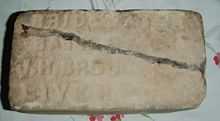Bath brick
The bath brick, patented in 1823 by William Champion and John Browne, was a predecessor of the scouring pad used for cleaning and polishing.
Bath bricks were made by a number of companies in the town of Bridgwater, England, from fine clay dredged from the River Parrett near Dunball.[1] By the end of the 19th century some 24 million bath bricks had been produced in Bridgwater for the home and international markets.
The brick, similar in size to an ordinary house brick, could be used in a number of ways. A mild abrasive powder could be scraped from the brick and used as a scouring powder on floors and other surfaces. Powder could also be moistened with water for use on a cloth for polishing or as a kind of sand paper. Items such as knives might be polished directly on a wetted brick.

References
External links
- extract from Mrs Beeton's Book of Household Management mentioning bath bricks